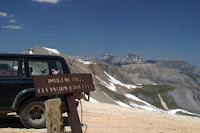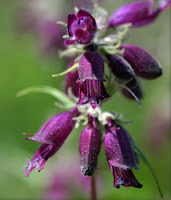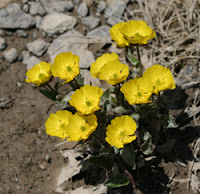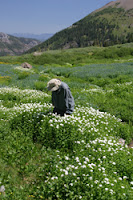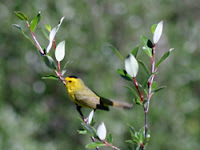The events described here took place July 20th.

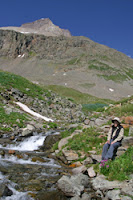 Today we decided to revisit the first area we explored on this trip: the Yankee Boy and Governor Basin area. The flowers had been very good nearly two weeks ago, but not yet completely out at the higher (alpine) altitudes. We hoped to see more alpine flowers this time, and perhaps to get a little further into Governor Basin (where we had been stopped by a large snowbank before). The photo immediately at right is along the brook that emerges from the Blue Lakes (which were above us and out of our sight), tumbling through a sub-alpine gulch and bordered by lush wildflowers. We took a half-mile or so walk along this stream that was most enjoyable. At far right is one of the small lakes that lies near the highest point reached by the road in Yankee Boy Basin, at about 12,600 feet altitude. There is a footpath that continues on to Blue Lakes and Mt. Sneffels summit, but we did not take these. While there were a few more alpine flowers out, it wasn't a dramatic change from our first visit. But the sub-alpine flowers more than made up for the disappointment on the alpine flowers...
Today we decided to revisit the first area we explored on this trip: the Yankee Boy and Governor Basin area. The flowers had been very good nearly two weeks ago, but not yet completely out at the higher (alpine) altitudes. We hoped to see more alpine flowers this time, and perhaps to get a little further into Governor Basin (where we had been stopped by a large snowbank before). The photo immediately at right is along the brook that emerges from the Blue Lakes (which were above us and out of our sight), tumbling through a sub-alpine gulch and bordered by lush wildflowers. We took a half-mile or so walk along this stream that was most enjoyable. At far right is one of the small lakes that lies near the highest point reached by the road in Yankee Boy Basin, at about 12,600 feet altitude. There is a footpath that continues on to Blue Lakes and Mt. Sneffels summit, but we did not take these. While there were a few more alpine flowers out, it wasn't a dramatic change from our first visit. But the sub-alpine flowers more than made up for the disappointment on the alpine flowers...

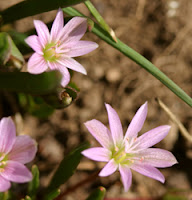 Both of the flowers at right are mysteries to us. At far right, the white flower is one that when we first spotted it a few days ago on the forest floor, we thought we'd discovered something unusual. We didn't know the flower, and it was uncommon. Within a day or two we were seeing it everywhere, and nowhere in such abundance as along the roads in Yankee Boy and Governor Basin, just below timberline. It has very little fragrance, grows in bunches that sometimes mass into large arrays, but has very oddly shaped individual blossoms with twisted petals. The other flower really was unusual; we saw it in only a couple of places near newly melted snow. The violet color stands out dramatically against the otherwise not-yet-sprouted background. They're very tiny and low; big enough to spot easily, but not massing up like so many other flowers here do.
Both of the flowers at right are mysteries to us. At far right, the white flower is one that when we first spotted it a few days ago on the forest floor, we thought we'd discovered something unusual. We didn't know the flower, and it was uncommon. Within a day or two we were seeing it everywhere, and nowhere in such abundance as along the roads in Yankee Boy and Governor Basin, just below timberline. It has very little fragrance, grows in bunches that sometimes mass into large arrays, but has very oddly shaped individual blossoms with twisted petals. The other flower really was unusual; we saw it in only a couple of places near newly melted snow. The violet color stands out dramatically against the otherwise not-yet-sprouted background. They're very tiny and low; big enough to spot easily, but not massing up like so many other flowers here do.
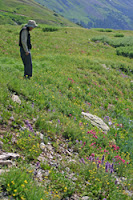
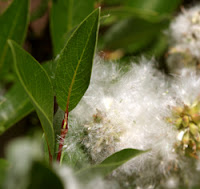 At far right is another scene by the brook we walked along. Each time we turned a corner on this walk, we were presented with another rock garden like this, full of mixed wildflowers of all colors, but trending strongly toward the blues and lavendars. Down near the brook itself, the scene was dominated by the fragrant white flower we love so much, and the deep violet of Parry's Primrose. At left, from a much lower altitude, is a mature pussy willow seed "pod", exploded and letting seeds get carried along by the wind. There were several species of willow very commonly found both above and below timberline. As you'd expect, most of these were found near water, including substantial stands of dwarfed willow at the higher, alpine altitudes. These won't be mature for some time yet, their season being delayed by the cold that comes along with altitude.
At far right is another scene by the brook we walked along. Each time we turned a corner on this walk, we were presented with another rock garden like this, full of mixed wildflowers of all colors, but trending strongly toward the blues and lavendars. Down near the brook itself, the scene was dominated by the fragrant white flower we love so much, and the deep violet of Parry's Primrose. At left, from a much lower altitude, is a mature pussy willow seed "pod", exploded and letting seeds get carried along by the wind. There were several species of willow very commonly found both above and below timberline. As you'd expect, most of these were found near water, including substantial stands of dwarfed willow at the higher, alpine altitudes. These won't be mature for some time yet, their season being delayed by the cold that comes along with altitude.
As usual, you can click on any photo for a larger view.

